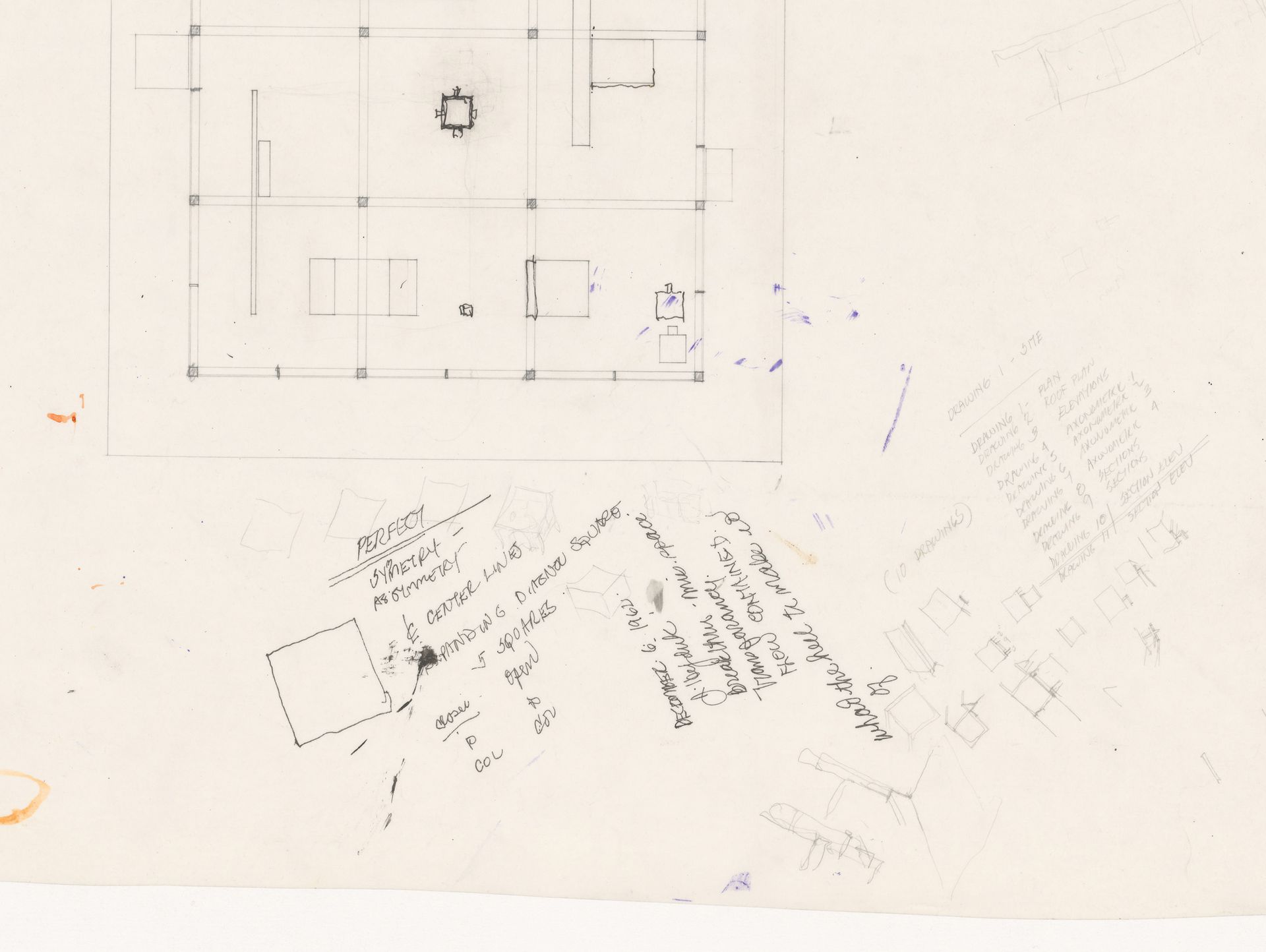John Hejduk Exhibition
January 22–February 16, 1980
Statement, John Hejduk
In the Fall of 1954 I conceived a plan to make ten house projects over a period of ten years. The study was to be an investigation. An investigation into the generators of architectural form. The heart of the matter was precision and detail. By 1963 the investigation of the nine squares terminated; five houses completed, two houses in process. It had to do with a development of a methodology and of a construction.
The structures were columns and beams. Also piers, and walls, and slabs.
The materials were steel, glass, concrete and wood; masonry and plaster, too.
The projects were drawn on Albanene vellum #197, or was it #194?? The pencils were of 6H to H lead encased in wood. An eraser was used, soap type, but rarely.
The temperatures of the air ranged from 110 degrees Fahrenheit to approximately 55 degrees Fahrenheit.
The work was simply carried out in a disinterested atmosphere that was very dry.
After spending days with folders upon folders, what seems urgent about his work is how you can feel someone within it, within a body of work. Hejduk is the opposite of corporate professionalism, or mechanical rationalism. He is a thinking architect—with false starts, dead-ends, desires, stammerings, stutters, experiments, and brilliant inventions all on display. Nowadays so many aspire toward becoming an entrepreneurial office, toward instant commercial success, or toward being Internet-and-Instagram famous. Hejduk represents the reverse of this. He was looking inward as much as outward. He was more interested in finding something meaningful. And I feel like I know some part of him through his work. I am sure he wanted success, wanted to have important ideas, and wanted to be at the same level of those he admired. But he was an architect, artist, and a poet by being himself—even, or especially, when he was at his most architecturally mannered, disciplinary, and formal.
As I became more and more obsessed with lists and list-making, I Googled. I asked friends and historians. I couldn’t find a definitive text on the technique of lists in art or architecture, so I assembled a small bibliography from various recommendations. Lists are part of conceptual art, administration art, seriality, positivism, math art, post-WWII literature and art. Still, the format feels urgent and contemporary. Lists are how we communicate through fragments, how we code, how we schedule things, how we . . . Whenever I see lists in art they are either positivist or absurd . . . or both. They simultaneously collect and disassemble. They treat language as physical matter, a piling up of words. They have a quality of exhaustion.
A short bibliography (compiled quickly):
Robert Smithson and his obsession with language games, heaps of language
Robert Morris’s “MD Rx”
On Kawara’s work
Adorno’s description of parataxis in Holderlin’s poetry
The work of Georges Perec (think: Life: A User Manual or An Attempt at Exhausting a Place in Paris or I Remember) who has since the CCA visit become one of my favorite writers (I will probably never be able to think about Hejduk without Perec)
David Foster Wallace’s The Pale King
Carl Andre’s text pieces
Sol Lewitt’s Instructions
Richard Serra’s Verb List (1967–1968)
Lawrence Weiner’s Statements (more instructions)
Lynne Tillman’s “The Last Words Are Andy Warhol”
Event Scores by George Brecht, Yoko Ono, La Monte Young (from Liz Kotz, also see this PDF)
Specifically, George Brecht’s Three Chair Events
Dan Graham (so much) Homes for America, Schema (March 1966), March 31, 1966
Terry Atkinson and Michael Baldwin’s Types of Quasi Intention
Liz Kotz’s book on language, Words to Be Looked At
Eventually, it is time to leave the CCA. It is impossible to know where you will end up once you start looking at things, and one thing we found in the vaults was an old cassette tape with unknown contents labelled “Hejduk”. Out of curiosity I asked the CCA to digitize it, and a few weeks later I received a link. It turned out to be a strange and brilliant conversation between Peter Eisenman and John Hejduk. I have listened to it a few times, and am listening to it as I write this. Hopefully the CCA put it online. The conversation is amazingly weird, like overhearing a phone call between good friends talking about ideas, fighting, and making fun of each other. The recording stops abruptly after an hour, left incomplete. But while listening, it becomes clear that both architects live within a world of ideas and of culture—one that they are trying to contribute to. For better or worse, this world—their world—is the world of lists: of ideas, of history, of bibliographies, of archives.






























